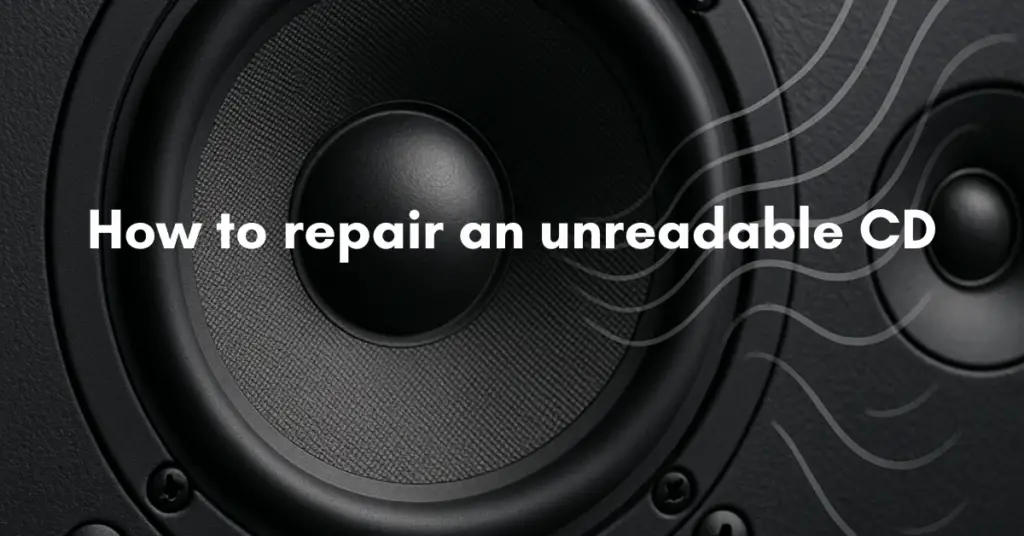An unreadable CD can be frustrating, especially when it contains important music, data, or personal content. CDs become unreadable when their surface is scratched, smudged, or physically damaged, making it difficult for the laser to follow the microscopic data track. While not every disc can be saved, many unreadable CDs can be repaired using cleaning, resurfacing, and careful restoration techniques. Understanding why the disc fails and how to fix it greatly improves the chance of recovery.
1. Identify Why the CD Is Unreadable
Before attempting repairs, determine the type of damage. Common issues include:
• Fingerprints, smudges, and dirt on the shiny side
• Light scratches across the reading surface
• Deep scratches that interrupt the data spiral
• A cloudy or hazy coating from age or oxidation
• Cracks near the center hub
• Delamination where the reflective layer peels
• Moisture or residue from improper storage
Most repairable issues involve surface scratching or contamination. Damage to the top label side, however, is usually catastrophic because the data layer sits just beneath it.
2. Clean the CD Properly
Many unreadable CDs fail simply because the laser cannot see through surface dirt. Clean the disc using:
• Soft microfiber cloth
• Lukewarm water
• Mild dish soap (optional)
Avoid circular wiping. Instead, wipe in straight lines from the center outward, which reduces the risk of worsening scratches. Dry with a lint-free cloth.
3. Remove Light Scratches
Light scratches scatter the laser and break tracking. Several safe methods can reduce their visibility:
Micro-abrasive polish:
Commercial CD polishes (like Novus 2 or dedicated disc repair fluids) gently smooth the surface. Apply a small amount and polish with a soft cloth using center-to-edge strokes.
Toothpaste method (mild abrasive only):
Use non-gel, non-whitening toothpaste. Rub lightly from center outward, rinse with lukewarm water, and dry. This can reduce surface scratches enough for the laser to regain focus.
4. Repair Medium to Deep Scratches
More severe scratches may require resurfacing, a process that sands off a very thin layer of plastic to reveal a cleaner surface. Options include:
• Professional disc resurfacing machines
• Consumer-grade disc repair machines
• Disc buffing services at game stores or libraries
Resurfacing is one of the most effective ways to restore unreadable CDs, especially game discs, audio CDs, and data discs with only surface damage.
5. Fix Label-Side Damage (If Possible)
The data layer in CDs is just beneath the label side. If scratched, it often cannot be fully repaired. However, minor label scratches may be stabilized using:
• Clear tape over damaged areas to prevent peeling
• Gentle cleaning only on the printed surface
If silver flakes or pinholes are visible through the disc, data loss is likely permanent.
6. Address Moisture, Fogging, or Cloudiness
Discs stored in damp or hot environments may develop a hazy layer. Cleaning with mild soap and water often works. If the disc has fungus or mold, wipe with isopropyl alcohol (not acetone) and dry immediately.
7. Try Different Types of CD Players
Sometimes the issue is the player, not the disc. Different drives have different tolerance levels.
Try the disc in:
• Older CD players (often more forgiving)
• Computer DVD or Blu-ray drives
• Game consoles
• External USB drives
Computer drives especially can read heavily damaged discs using stronger error correction.
8. Use Software for Data Recovery (For Data CDs)
If the disc partially reads, data-recovery software can extract the readable portions before the disc fails completely. Popular tools include IsoBuster, CD Recovery Toolbox, and ddrescue. These programs repeatedly scan the disc to salvage as much data as possible.
9. Avoid Harmful “Fixes”
Some widely circulated methods can destroy the disc. Avoid:
• Vegetable oils or cooking oils
• Furniture polish
• Window cleaner
• Abrasive powders
• Acetone or harsh solvents
These can cloud the plastic, dissolve coatings, or leave residues that worsen readability.
10. When the CD Cannot Be Repaired
A disc is likely beyond repair if:
• The reflective layer is peeled or missing
• There are cracks extending into the data area
• The disc is warped
• Deep gouges reach the data layer
These types of damage prevent the laser from ever reading the encoded information.
Repairing an unreadable CD is often possible when the problem is limited to surface scratches, dirt, or cloudiness. Cleaning, polishing, and resurfacing can restore many discs to playable condition. Data-recovery software can rescue files from partially damaged discs, while alternative players may read discs your primary player cannot. However, damage to the data layer or reflective coating is typically permanent. Taking proper care of discs—storing them vertically, avoiding sunlight, and handling them carefully—helps prevent unreadable conditions in the future.

